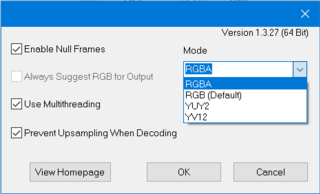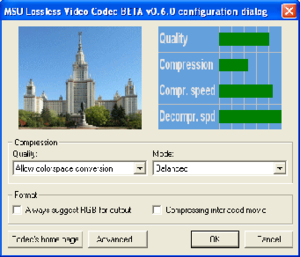In information theory, data compression, source coding, or bit-rate reduction is the process of encoding information using fewer bits than the original representation. Any particular compression is either lossy or lossless. Lossless compression reduces bits by identifying and eliminating statistical redundancy. No information is lost in lossless compression. Lossy compression reduces bits by removing unnecessary or less important information. Typically, a device that performs data compression is referred to as an encoder, and one that performs the reversal of the process (decompression) as a decoder.

In information technology, lossy compression or irreversible compression is the class of data compression methods that uses inexact approximations and partial data discarding to represent the content. These techniques are used to reduce data size for storing, handling, and transmitting content. The different versions of the photo of the cat on this page show how higher degrees of approximation create coarser images as more details are removed. This is opposed to lossless data compression which does not degrade the data. The amount of data reduction possible using lossy compression is much higher than using lossless techniques.
Windows Media Audio (WMA) is a series of audio codecs and their corresponding audio coding formats developed by Microsoft. It is a proprietary technology that forms part of the Windows Media framework. WMA consists of four distinct codecs. The original WMA codec, known simply as WMA, was conceived as a competitor to the popular MP3 and RealAudio codecs. WMA Pro, a newer and more advanced codec, supports multichannel and high resolution audio. A lossless codec, WMA Lossless, compresses audio data without loss of audio fidelity. WMA Voice, targeted at voice content, applies compression using a range of low bit rates. Microsoft has also developed a digital container format called Advanced Systems Format to store audio encoded by WMA.
The Apple Lossless Audio Codec (ALAC), also known as Apple Lossless, or Apple Lossless Encoder (ALE), is an audio coding format, and its reference audio codec implementation, developed by Apple Inc. for lossless data compression of digital music. After initially keeping it proprietary from its inception in 2004, in late 2011 Apple made the codec available open source and royalty-free. Traditionally, Apple has referred to the codec as Apple Lossless, though more recently it has begun to use the abbreviated term ALAC when referring to the codec.

Huffyuv is a lossless video codec created by Ben Rudiak-Gould which is meant to replace uncompressed YCbCr as a video capture format. The codec can also compress in the RGB color space.
QuickTime Animation format is a video compression format and codec created by Apple Computer to enable playback of RGB video in real time without expensive hardware. It is generally found in the QuickTime container with the FourCC 'rle '. It can perform either lossless or lossy compression and is one of the few video codecs that supports an alpha channel. Supported color depths are 1-bit (monochrome), 15-bit RGB, 24-bit RGB, 32-bit ARGB, as well as palettized RGB. As a result of reverse-engineering of the format, a decoder is implemented in XAnim as well as an encoder and decoder in libavcodec.

Lagarith is an open source lossless video codec written by Ben Greenwood. It is a fork of the code of HuffYUV and offers better compression at the cost of greatly reduced speed on uniprocessor systems. Lagarith was designed and written with a few aims in mind:
A camera raw image file contains unprocessed or minimally processed data from the image sensor of either a digital camera, a motion picture film scanner, or other image scanner. Raw files are so named because they are not yet processed, and contain large amounts of potentially redundant data. Normally, the image is processed by a raw converter, in a wide-gamut internal color space where precise adjustments can be made before conversion to a viewable file format such as JPEG or PNG for storage, printing, or further manipulation. There are dozens of raw formats in use by different manufacturers of digital image capture equipment.
Microsoft Video 1 or MS-CRAM is an early lossy video compression and decompression algorithm (codec) that was released with version 1.0 of Microsoft's Video for Windows in November 1992. It is based on MotiVE, a vector quantization codec which Microsoft licensed from Media Vision. In 1993, Media Vision marketed the Pro Movie Spectrum, an ISA board that captured video in both raw and MSV1 formats.
Α video codec is software or a device that provides encoding and decoding for digital video, and which may or may not include the use of video compression and/or decompression. Most codecs are typically implementations of video coding formats.
JPEG XR is an image compression standard for continuous tone photographic images, based on the HD Photo specifications that Microsoft originally developed and patented. It supports both lossy and lossless compression, and is the preferred image format for Ecma-388 Open XML Paper Specification documents.
FFV1 is a lossless intra-frame video coding format. It can use either variable-length coding or arithmetic coding for entropy coding. The encoder and decoder are part of the free, open-source library libavcodec in the project FFmpeg since June 2003. FFV1 is also included in ffdshow and LAV Filters, which makes the video codec available to Microsoft Windows applications that support system-wide codecs over Video for Windows (VfW) or DirectShow. FFV1 is particularly popular for its performance regarding speed and size, compared to other lossless preservation codecs, such as M-JPEG2000. The European Broadcasting Union (EBU) lists FFV1 under the codec-family index "31" in their combined list of video codec references.

WebP is a raster graphics file format developed by Google intended as a replacement for JPEG, PNG, and GIF file formats. It supports both lossy and lossless compression, as well as animation and alpha transparency.
YULS or YUVsoft's Lossless Video Codec, a lossless video codec developed by YUVsoft, was designed to produce highly compressed lossless video. YULS compares favorably, in terms of compression ratio, with other codecs.
Apple Video is a lossy video compression and decompression algorithm (codec) developed by Apple Inc. and first released as part of QuickTime 1.0 in 1991. The codec is also known as QuickTime Video, by its FourCC RPZA and the name Road Pizza. When used in the AVI container, the FourCC AZPR is also used.
QuickTime Graphics is a lossy video compression and decompression algorithm (codec) developed by Apple Inc. and first released as part of QuickTime 1.x in the early 1990s. The codec is also known by the name Apple Graphics and its FourCC SMC. The codec operates on 8-bit palettized RGB data. The bit-stream format of QuickTime Graphics has been reverse-engineered and a decoder has been implemented in the projects XAnim and libavcodec.

An audio coding format is a content representation format for storage or transmission of digital audio. Examples of audio coding formats include MP3, AAC, Vorbis, FLAC, and Opus. A specific software or hardware implementation capable of audio compression and decompression to/from a specific audio coding format is called an audio codec; an example of an audio codec is LAME, which is one of several different codecs which implements encoding and decoding audio in the MP3 audio coding format in software.
JPEG XL is a royalty-free raster-graphics file format that supports both lossy and lossless compression. It is designed to outperform existing raster formats and thus become their universal replacement.





